|
|
||||||||||||||||||||||||||||||||||||||||||||||||||||||||||
|
Please sign my Guestbook and leave feedback |
||||||||||||||||||||||||||||||||||||||||||||||||||||||||||
|
Recent Additions |
||||||||||||||||||||||||||||||||||||||||||||||||||||||||||
|
Let’s recap. So far we have looked at fifteen churches which I show again in the table below. The group is defined by each church having at least one of three things: a distinctive “mooning figure”, an equally distinctive “flea” carving or the presence of a hitchhiker gargoyle. These are what I call the Mooning Men Group of churches - or the MMG. As Owston and Empingham are distinguished only by a hitchhiker gargoyle we are not going to talk much about them. It is possible that the Gargoyle Master was working independently at these two churches or that the or else other distinguishing marks have been lost to history. I believe the former to be the more likely explanation and we will see later that at least one of the MMG masons spread his wings well outside this group of churches. Conversely, I have included Ryhall Church which has none of those three distinguishing trademarks but which clearly employed a mason seen also at Oakham We have seen there are two other less obvious distinguishing features: the goffered caul headdress that allows us to date the work to the later fourteenth or early fifteenth century and the curious black leaded eyes. So in all we have no fewer than five characteristics that allow us to assume we are seeing the the activities of an organised group of masons and other craftsman. Below I reproduce a table I included earlier and I have added a column to show where the friezes have at last one figure with black eyes. This does not include gargoyles. |
|
|
* By my own definition a Minor Frieze is one that is on the tower only. |
|
We have discovered two specific masons already: the Gargoyle Master and the man who carved at both Oakham and Ryhall. Given that we are looking at a group of thirteen churches (f we exclude Empingham and Owston) then you might expect that there would be more. And you would be right! I hope to show that there are at least five different styles to be seen, some with additional trademarks of their own. Whether these five styles to equate to five men is another matter. We cannot know the names of any of these men but I intend to give them names for the sake of clarity. |
|
Style A “Simon Cottesmore” |
|||||||||
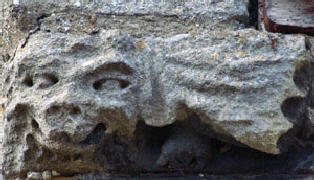 |
|||||||||
 |
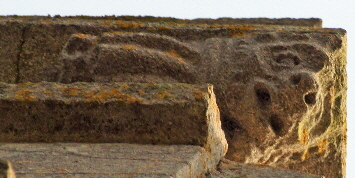 |
||||||||
|
Griffins on ends of friezes at (left to right): Cottesmore, Buckminster, Hungarton |
|||||||||
|
The three pictures above are of carved griffons - lions with dragon wings. Well, that’s what they look like to me although we can’t know what the mason had in mind. Each of them is at the corner of a frieze and they are clearly carved by the same hand. Note the way they eyes are represented. Each carving has distinct eyeballs within ovaloid eye sockets. These are a trademark carvings not of an organisation or a team of men but of an individual mason. However, that mason was still working within the MMG team. All three of the churches have mooner and fleas carvings. In fact Cottesmore has three of each for good measure. So we are drilling down here from the collective team to the individual carver. of the three churches, Cottesmore has by far the largest body of sculptural work so I dubbed the man “Simon Cottesmore”. Let us have a look at the friezes at those three places. |
 |
||||||||||||||||||||||||||||||||||||||||||||||||||||||||||||||||||||||||||||||||||||||||||||||
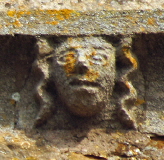 |
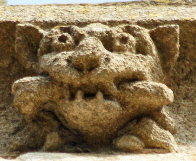 |
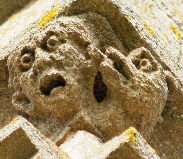 |
||||||||||||||||||||||||||||||||||||||||||||||||||||||||||||||||||||||||||||||||||||||||||||
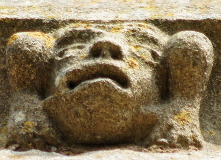 |
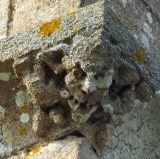 |
 |
||||||||||||||||||||||||||||||||||||||||||||||||||||||||||||||||||||||||||||||||||||||||||||
|
Hungarton Church has a frieze only on its tower. In the pictures above you can see that there are other examples of carvings with the oval eyes we saw in the griffins, albeit less elaborately carved. Others, however have drilled holes for eyes and more mischievous subjects. So although Simon Cottesmore was here, so too it seems, was another decorative mason. Note very carefully in the top picture how the frieze is actually made up of short pieces of cornice with only one or two or even three carvings on each. This meant that more than one mason could sculpt for the frieze at one time. You do not see two different styles on one length of cornice. |
||||||||||||||||||||||||||||||||||||||||||||||||||||||||||||||||||||||||||||||||||||||||||||||
 |
||||||||||||||||||||||||||||||||||||||||||||||||||||||||||||||||||||||||||||||||||||||||||||||
 |
||||||||||||||||||||||||||||||||||||||||||||||||||||||||||||||||||||||||||||||||||||||||||||||
|
Buckminster has lengths of frieze only on its south side. In the pictures you can see the same relatively unsophisticated style as as at Hungarton and again the inset eyeballs. The one at the left of the top picture looks as if it might be a replacement. |
||||||||||||||||||||||||||||||||||||||||||||||||||||||||||||||||||||||||||||||||||||||||||||||
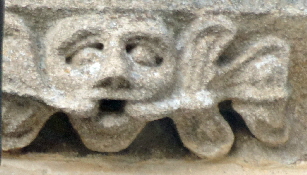 |
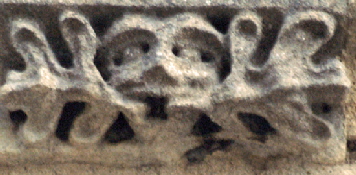 |
|||||||||||||||||||||||||||||||||||||||||||||||||||||||||||||||||||||||||||||||||||||||||||||
|
Green man images clearly by the same mason - Simon Cottesmore - and again with inset eyeballs at (left) Buckminster and (right) Cottesmore. Green man images are not nearly as common on the outsides of churches as on the insides. |
||||||||||||||||||||||||||||||||||||||||||||||||||||||||||||||||||||||||||||||||||||||||||||||
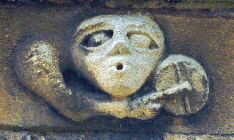 |
 |
 |
||||||||||||||||||||||||||||||||||||||||||||||||||||||||||||||||||||||||||||||||||||||||||||
|
Images from Cottesmore frieze. The friezes here are very much more extensive than at Hungarton and Buckminster as they cover both sites and both clerestories. There are plenty of inset eyeballs to see and a couple of rather cheery looking lions a little akin to the griffons. |
||||||||||||||||||||||||||||||||||||||||||||||||||||||||||||||||||||||||||||||||||||||||||||||
|
Simon seems also to have sculpted large portion of the tower frieze at Harlaxton Church. |
||||||||||||||||||||||||||||||||||||||||||||||||||||||||||||||||||||||||||||||||||||||||||||||
 |
 |
|||||||||||||||||||||||||||||||||||||||||||||||||||||||||||||||||||||||||||||||||||||||||||||
 |
||||||||||||||||||||||||||||||||||||||||||||||||||||||||||||||||||||||||||||||||||||||||||||||
|
Sections of the Tower Frieze, Harlaxton Church. Note the spacing error in the picture top right. The section of the frieze with the broken head has its carving a little too much to the right. The friezes were a little like jigsaws: the sum of the lengths of the individual parts must, of course, add up to the total length of the parapet. So too, though, must the individual sculptures be positioned on each length in order to give even spacing throughout the entire length. Here, as at other sites, it didn’t always work out. |
||||||||||||||||||||||||||||||||||||||||||||||||||||||||||||||||||||||||||||||||||||||||||||||
|
Harlaxton, however, has no griffon or any other carving that positively parallels those at “his” other three churches. Moreover, the sculptures show better technical skills. What is unknowable for us, however, is what the constraints were under which the sculptural masons worked. These were not “centre-piece” carvings of saints or apostles but decorative friezes. We do not know whether the friezes were specified within the contract, whether their quality was specified, whether they were paid for separately. Nor do we know whether they were the subjects of side-documents. Without this we are unable to know why some friezes were better than others. Certainly, of all of the friezes within this study, those at Cottesmore and Buckminster are amongst the worst, if not the worst. Harlaxton’s is a distinct improvement but we cannot know whether this was because of commercial or aesthetic demands placed upon him or whether he he just took more care or had acquired more skill. Harlaxton differs from the other Simon Cottesmore churches in that here is no mooning man here nor any obvious gap where one might once have been. There is, however, a flea. |
||||||||||||||||||||||||||||||||||||||||||||||||||||||||||||||||||||||||||||||||||||||||||||||
|
Style B “Lawrence of Leicester” |
||||||||||||||||||||||||||||||||||||||||||||||||||||||||||||||||||||||||||||||||||||||||||||||
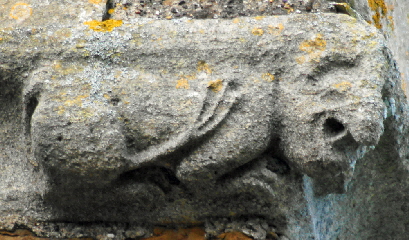 |
||||||||||||||||||||||||||||||||||||||||||||||||||||||||||||||||||||||||||||||||||||||||||||||
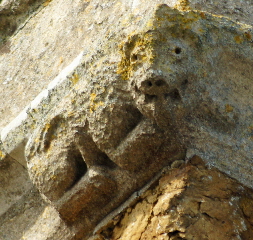 |
||||||||||||||||||||||||||||||||||||||||||||||||||||||||||||||||||||||||||||||||||||||||||||||
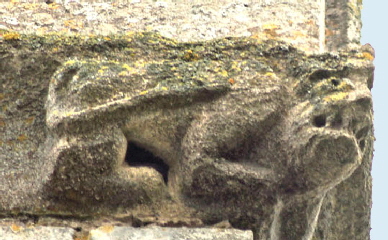 |
||||||||||||||||||||||||||||||||||||||||||||||||||||||||||||||||||||||||||||||||||||||||||||||
|
End-of-Frieze lion carvings at (left to right) Wymondham, Knossington, Tilton-on-the-Hill |
||||||||||||||||||||||||||||||||||||||||||||||||||||||||||||||||||||||||||||||||||||||||||||||
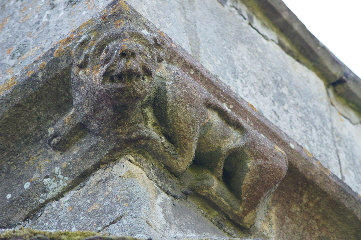 |
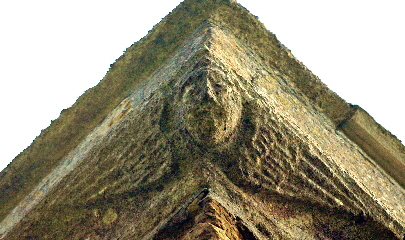 |
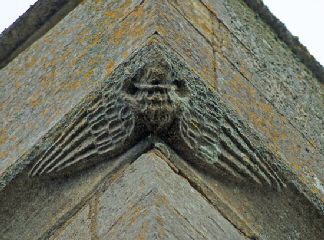 |
||||||||||||||||||||||||||||||||||||||||||||||||||||||||||||||||||||||||||||||||||||||||||||
|
Left: End-of-Frieze Lion Carving at Lowesby Centre: Winged Face at Knossington. Right: Winged face at Wymondham |
||||||||||||||||||||||||||||||||||||||||||||||||||||||||||||||||||||||||||||||||||||||||||||||
|
The lions - if that is what they are intended to be - shown in the pictures above are quite clearly by the same mason. The creatures have quite cheerful toothy grins and crouch on fat haunches. Those at Tilton and Knossington both have trident-like ends to their tails. All appear at the ends of friezes or corners of two friezes. As usual, they are not identical but all are clearly by the same mason. Winged faces at Knossington and Wymondham are also on the corners and also clearly by the same mason. This is the man I call “Lawrence of Leicester” and that is because all of these four churches are in Leicestershire. This is not an inventive mason. His subject matter is conservative. The style, however, is reasonably distinctive. Faces of men or beasts tend to be cheerful in demeanour. Interestingly, none of these four churches has a flea carving, although all four have mooning men. This contrasts with Simon Cottesmore’s churches where all of them have a flea! We might then make an assumption that the flea is Simon’s own motif and that Lawrence eschewed it. A nice neat division. However, we are confounded by the fact that a flea appears amongst the frieze on the south transept of Langham Church where the sculptor seems to be Lawrence and is most certainly not Simon. |
||||||||||||||||||||||||||||||||||||||||||||||||||||||||||||||||||||||||||||||||||||||||||||||
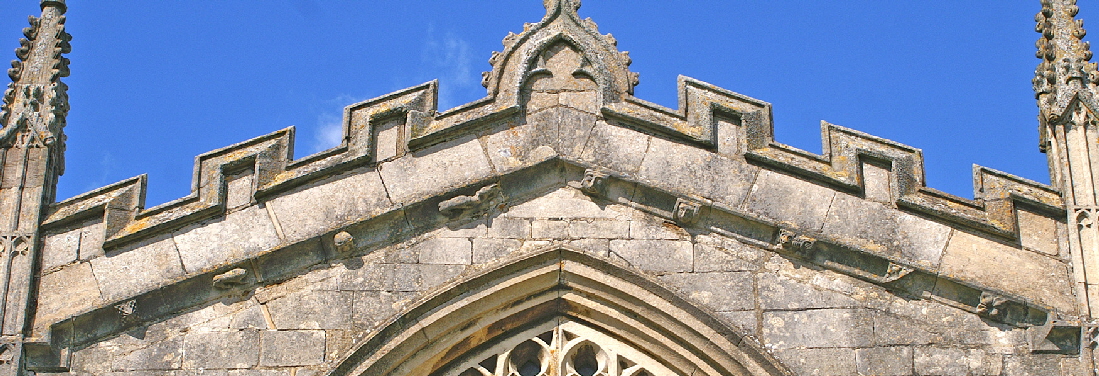 |
||||||||||||||||||||||||||||||||||||||||||||||||||||||||||||||||||||||||||||||||||||||||||||||
|
The south side of the south transept, Langham Church by “Lawrence of Leicester”. The mooner carving is third from the left. There are also two dogs fighting (third left), another dog (?) Third right. Note the high quality battlement design that is double chamfered and the sculpted pinnacles. Langham was a richly-endowed church. Simon de Langham (1310-76) who was born in the village was a Cardinal and Archbishop of Canterbury as well as one time Treasurer of England. |
||||||||||||||||||||||||||||||||||||||||||||||||||||||||||||||||||||||||||||||||||||||||||||||
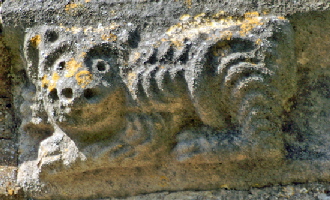 |
||||||||||||||||||||||||||||||||||||||||||||||||||||||||||||||||||||||||||||||||||||||||||||||
 |
 |
|||||||||||||||||||||||||||||||||||||||||||||||||||||||||||||||||||||||||||||||||||||||||||||
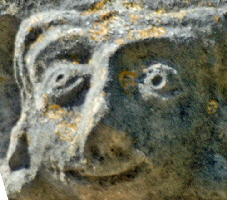 |
||||||||||||||||||||||||||||||||||||||||||||||||||||||||||||||||||||||||||||||||||||||||||||||
|
Lawrence of Leicester at Langham. Note the lady with the goffered caul headdress. |
||||||||||||||||||||||||||||||||||||||||||||||||||||||||||||||||||||||||||||||||||||||||||||||
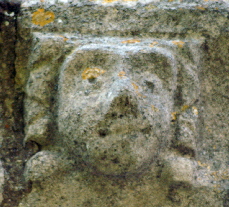 |
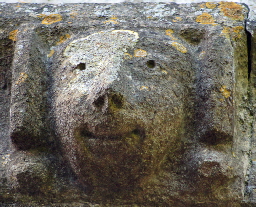 |
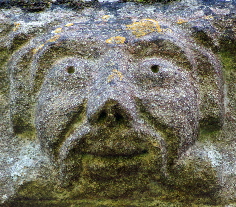 |
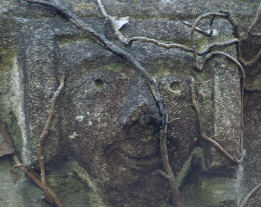 |
|||||||||||||||||||||||||||||||||||||||||||||||||||||||||||||||||||||||||||||||||||||||||||
|
Lawrence of Leicester at Lowesby with two goffered cauls and what is arguably a real life Green Lady (right) |
||||||||||||||||||||||||||||||||||||||||||||||||||||||||||||||||||||||||||||||||||||||||||||||
 |
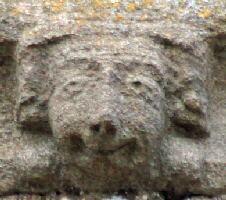 |
|||||||||||||||||||||||||||||||||||||||||||||||||||||||||||||||||||||||||||||||||||||||||||||
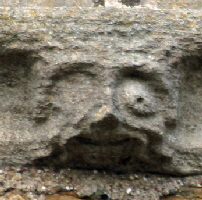 |
||||||||||||||||||||||||||||||||||||||||||||||||||||||||||||||||||||||||||||||||||||||||||||||
|
Lawrence of Leicester at Tilton-on-the-Hill |
||||||||||||||||||||||||||||||||||||||||||||||||||||||||||||||||||||||||||||||||||||||||||||||
|
Note that they eyes on Lawrence’s carvings are drilled holes. The noses have well-defined nostrils. The faces are invariably smiling. They are not mistakable for the work of Simon Cottesmore. So at this stage we have identified three masons: Simon Cottesmore, Lawrence of Leicester and the Gargoyle Master. They are easily distinguished from each other. All of the churches where Lawrence and Simon worked have mooners that they carved. We need to be very careful, however, to note that the presence of a carver on a church does not signify that he was the only carver. Things are very much more complicated than that. |
||||||||||||||||||||||||||||||||||||||||||||||||||||||||||||||||||||||||||||||||||||||||||||||
|
Style C “John Oakham” |
||||||||||||||||||||||||||||||||||||||||||||||||||||||||||||||||||||||||||||||||||||||||||||||
|
In the printed first edition of my book I placed John at only two churches within the MMG - at Oakham and Whissendine. I did note, however, that he had also carved at Brant Broughton Church in Lincolnshire, apparently alone, and outside the geographical area area of the Mooning Men Group. He had also carved the font at Muston Church also outside the area. Since that first edition I found his work at Exton Church in Rutland near to both Oakham and Whissendine. Harlaxton Church was also “undiscovered” for the first edition and we have already seen that friezes there were carved by Simon Cottesmore. I then discovered him at Boston and Swineshead in Lincolnshire. This caused me to widen my search geographically and, as we will see, John seems to have a had a career outside the Mooning Men Group either before or after their activities, We shall see that at four of these “extra” John Oakham churches - Exton, Harlaxton, Brant Broughton and Swineshead, the flea carving is present. Only at Exton, however, is there also a mooner. . John Oakham’s activities outside the geographical area are the subject of a separate chapter. For now only Harlaxton and Exton will be treated as MMG churches. John Oakham was a prolific carver and my name for him is derived from the huge body of work that he left at Oakham Church. His stock-in-trade is a grotesque face that looks rather like a synthesis of a man and a cow but which, in fact, is most likely to be a intended as a lion. |
||||||||||||||||||||||||||||||||||||||||||||||||||||||||||||||||||||||||||||||||||||||||||||||
 |
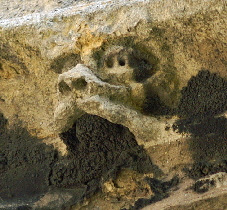 |
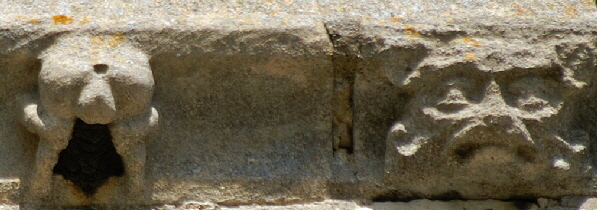 |
||||||||||||||||||||||||||||||||||||||||||||||||||||||||||||||||||||||||||||||||||||||||||||
|
John Oakham’s trademark lion face at Oakham Church with one adjacent (right) to a mooning man. |
||||||||||||||||||||||||||||||||||||||||||||||||||||||||||||||||||||||||||||||||||||||||||||||
 |
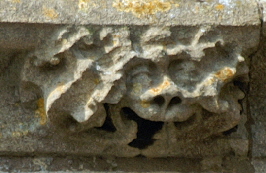 |
|||||||||||||||||||||||||||||||||||||||||||||||||||||||||||||||||||||||||||||||||||||||||||||
 |
||||||||||||||||||||||||||||||||||||||||||||||||||||||||||||||||||||||||||||||||||||||||||||||
|
John Oakham’s lions at Whissendine are a lot more cheerful in demeanour. |
||||||||||||||||||||||||||||||||||||||||||||||||||||||||||||||||||||||||||||||||||||||||||||||
 |
 |
|||||||||||||||||||||||||||||||||||||||||||||||||||||||||||||||||||||||||||||||||||||||||||||
|
John Oakham’s lion faces high up on the extremely lofty tower at Exton are understandably smaller. |
||||||||||||||||||||||||||||||||||||||||||||||||||||||||||||||||||||||||||||||||||||||||||||||
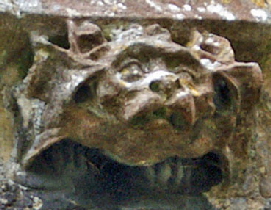 |
||||||||||||||||||||||||||||||||||||||||||||||||||||||||||||||||||||||||||||||||||||||||||||||
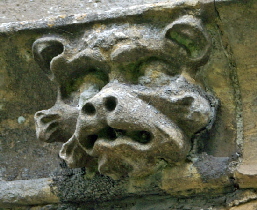 |
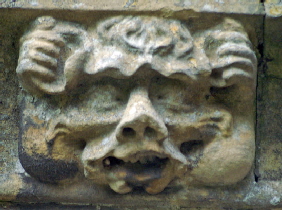 |
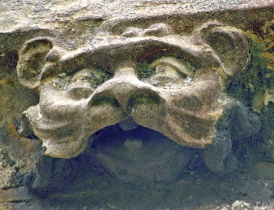 |
||||||||||||||||||||||||||||||||||||||||||||||||||||||||||||||||||||||||||||||||||||||||||||
|
John Oakham lions at Brant Broughton. This church was John’s magnum opus with apparently every carving on this lavishly decorated church being attributable to him. |
||||||||||||||||||||||||||||||||||||||||||||||||||||||||||||||||||||||||||||||||||||||||||||||
|
As with all of the masons, we need to focus closely on the eyes. We have seen the separate inserted eyeballs on some of Simon Cottesmore’s carvings. Lawrence of Leicester went in for simple drilled eye sockets. John, however, was much more sophisticated, carving proper eye sockets complete with eyelids and often with realistically-carved eyeballs and very characteristic cow-like ears. Overall, John’s lion heads are a very distinctive “look”. The problem is that, as at Exton, a stripped-down version of the lion’s lead is sometimes seen. John doesn’t always bother to carve his eyes in such detail and much of his output is not of lions heads! So his work is often very obvious but not always. We will be seeing that it is much easier to pin an individual sculptor to a church than it is to in and individual carving to a sculptor. |
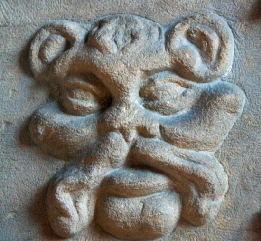 |
 |
 |
||||||||
|
John Oakham lions on the font at Muston, Lincolnshire. Note the characteristic eyes. |
||||||||||
|
So now we have four sculptors. Time now to look at the last of them, |
||||||||||
|
Style D: Ralf of Ryhall |
||||||||||
|
Ralf is named for his magnum opus which is Ryhall in Rutland, just a couple of miles from Stamford. Ryhall’s sculptural array is by some margin the most lavish in the MMG. But we have a problem: Ralf did not carve a mooning men at Ryhall. Nor did he carve a flea. He did carve women with goffered caul headdresses and this is the very home of carvings with black eyes but Ralf did not leave either of the two MMG trademarks. So why is it included here when the mooning mean has bee used as the defining trademark for this group? Well, to start with the link with Oakham is indisputable. I will also be showing probable links to both Tilton-on-the-Hill and Lowesby. We can only speculate as to why the trademarks are missing here and we will discuss that later. Ralf makes it a little more difficult for us as well in that he doesn’t have a recurring “look” nor a recurring carving. The eyes again, though, are distinctive, Ralf carves an eyeball but puts a drilled hole inside the ball. On some carvings this is filled with lead. Let’s begin with the very distinctive grotesques that are found on the south west side of Ryhall and the north west end of Oakham. |
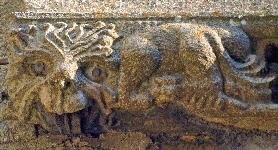 |
|||||||||||||||||||||||||||||||||||
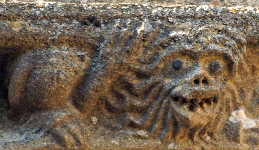 |
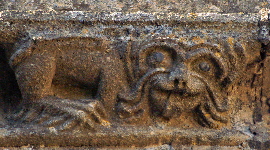 |
 |
|||||||||||||||||||||||||||||||||
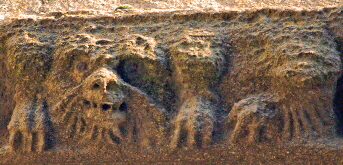 |
|||||||||||||||||||||||||||||||||||
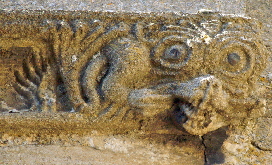 |
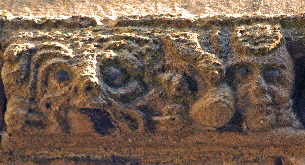 |
 |
|||||||||||||||||||||||||||||||||
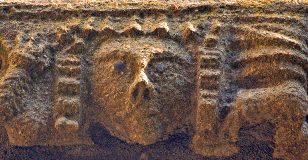 |
|||||||||||||||||||||||||||||||||||
 |
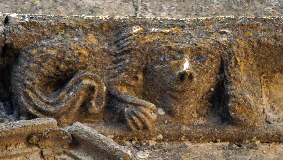 |
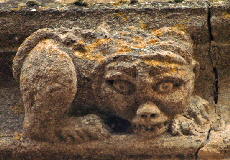 |
|||||||||||||||||||||||||||||||||
|
The beastly menagerie of Ryhall Church. All of these carvings with one exception are in cluster around the south porch and the south west aisle. The exception (bottom right) is found on the north aisle. All of these carvings except the north aisle example have black lead eyes and remarkably all seem to have survived. The north aisle carving does not have black eyes and in fact none of the carvings on that side of them. The broken carving (centre row, extreme right) was cut in half when an upper storey was added to the south porch. This resulted in the loss of perhaps half a dozen or so carvings that we must assume were of the same nature. Note the luxuriant manes and humorous dispositions of these beasts. The carving (centre row, second right) has a second black-eyed face to the right of the main figure. |
|||||||||||||||||||||||||||||||||||
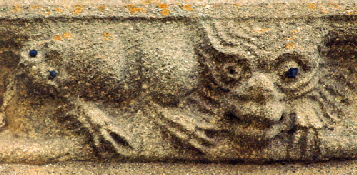 |
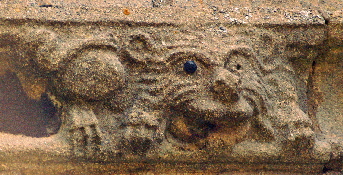 |
||||||||||||||||||||||||||||||||||
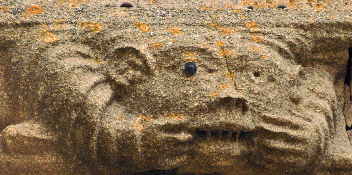 |
|||||||||||||||||||||||||||||||||||
 |
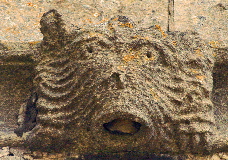 |
||||||||||||||||||||||||||||||||||
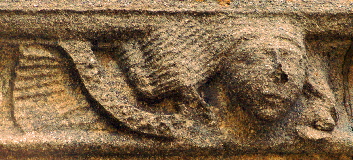 |
|||||||||||||||||||||||||||||||||||
 |
|||||||||||||||||||||||||||||||||||
|
Ralf of Ryhall’s Contribution to Oakham Church. The family resemblance to the Ryhall carvings is unmistakable. They are located on the west end of the north aisle and are the only frieze carvings at the church that have black eyes. Those eyes have not, however, survived as well as those at Ryhall and only one carving has retained both. The carvings are noticeably more weathered that at Ryhall which might be because of the use of a softer stone or possibly because of Oakham’s carvings being on the north side of the building. These are the only carvings on the church with black eyes and the predominant caver here was John Oakham. |
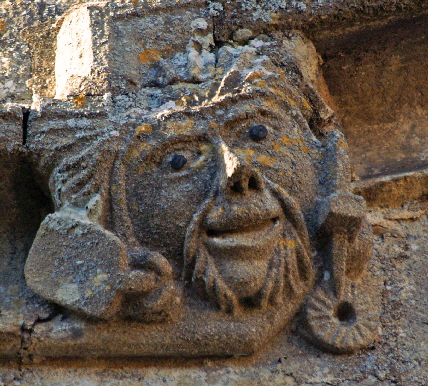 |
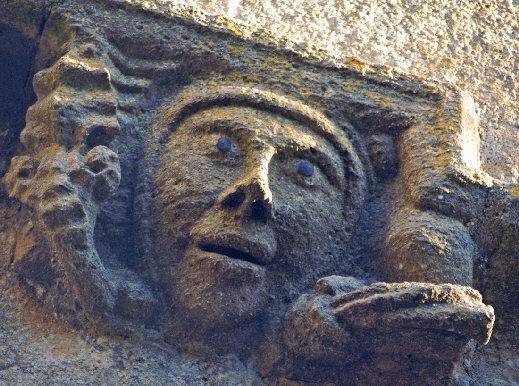 |
||||
|
Ryhall’s greatest treasures - overlooked by all and sundry - are these two carvings, also in the vicinity of the grotesque carvings shown above. They are on diametrically opposite positions to the north and south of the porch. What sets them apart is that they are naturalistic sculptures of men. The figure on the left holds a mason’s hammer and a millstone. His other hand holds what may be a bread shovel (used for putting in and removing loaves from bread ovens and in reality with a very long handle). Thus he represents three trades: mason, miller and baker. He has a luxuriant moustache and rather strange hair, carved in a style reminiscent of the grotesques. The figure on the right holds in one hand a flaming hammer and in the other what may be bolt of cloth or a sheaf of cereal. Thus he was probably showing the trades of blacksmith and either fulling or agricultural work. These are rare gems of carvings showing village life and deserve to be more widely known. |
|||||
|
So we have identified stonemasons if we include the Gargoyle Master. One or more of these five can be seen at each of the churches in the table above. |
|
|
Everything we have seen so far is, I believe, difficult to dispute. The five carving styles are distinctive and real. With the single exception of Ryhall a distinctive mooner carving is found in each church suggesting a collaborative group. Eight churches have fleas, reinforcing the notion of a group of masons. I have mentioned in passing that the flea carving exists at three churches outside the area being examined and I will be discussing this in a later chapter. Lead has been used on some carvings to form eyes, a rare occurrence in England as a whole but quite common here. We have seen the odd recurrence of the goffered caul headdress. Case closed, you might feel. What is not at all obvious from what I have written so far, however, is that we have only scratched the surface of the vast corpus of sculpture on the friezes of these churches. We have looked at the obvious. There are hundreds of carvings that cannot be immediately ascribed to these masons. By the same token, are we to conclude that Ralf of Ryhall carved twenty or so stunning carvings at Ryhall and Oakham and then hung up his hammer? There is a bigger picture here and the deeper we go the more we will be descending into the realms of assumption and subjectivity - although, I like to think, not too far! So next up are two sections that address this. |
|
Recommended next Section: Church Building in the post-Plague Era |
|||
|
Styles of Sculpture (you are here!) Church Building in the Post-Plague Era |
|||